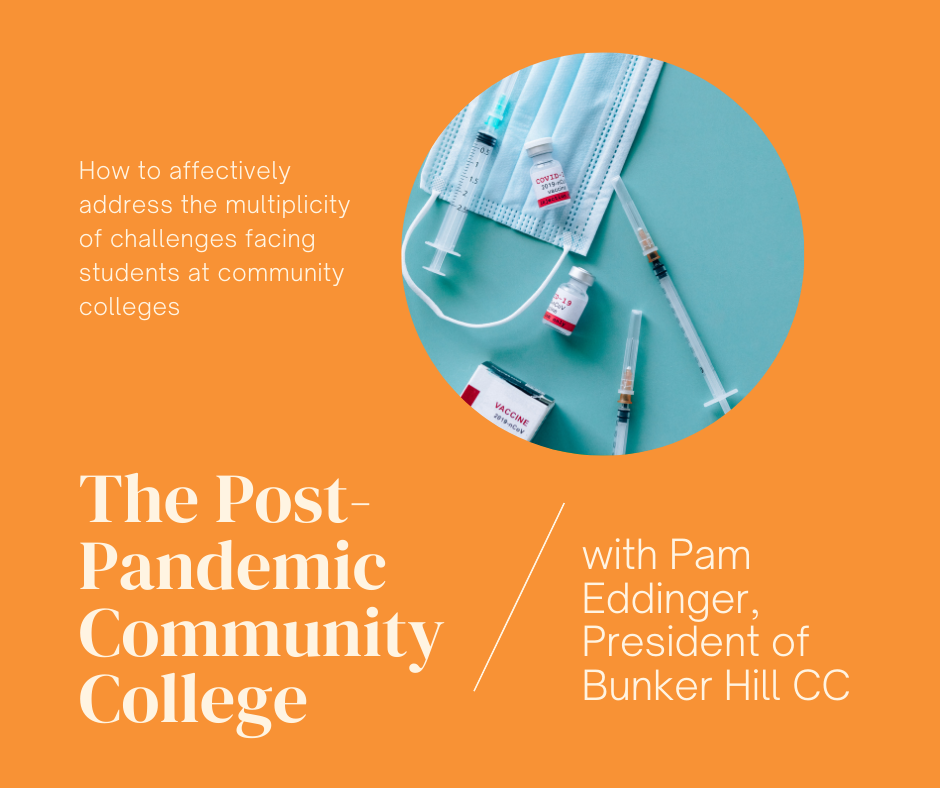The Post-Pandemic Community College
Community colleges have a crucial role in providing higher education to Americans.
In fact, enrolling in community college is becoming more and more common. A study conducted by the College Board found that in 2014, nearly half, or42%, of all undergraduate students were enrolled at a community college. Of all students who completed a 4-year bachelor’s degree during the 2015-2016 academic year, 49% of those students previously enrolled in a community college course.Students enrolled in 2-year colleges are also more likely to be students of color and less likely to be wealthy. Black and Hispanic students are overrepresented at community colleges, and students at these institutions are more likely to default on their loans.
At Bunker Hill Community College in Charlestown, student demographics are consistent with these national trends.61% of the students at Bunker Hill are students of color.
On May 25th we invited Pam Eddinger, the President of Bunker Hill Community College, to take part in a discussion about supporting community college students during and after the pandemic. As the previously mentioned statistics might suggest, the students at Bunker Hill are not particularly wealthy. Even the college’s international students — often labeled as ‘piggy banks for college budgets’ — are not generally the children of affluent and wealthy individuals.
The international students, as Pam describes them, are the talented young men and women “in a village that have scraped together enough money for him or her to go abroad, so that they can bring back that solution to that very poor village.”
For many students at Bunker Hill and other community colleges, the pandemic has imposed a greater financial strain on their already stretched-thin lives. In a 2019 survey of 167,000 college students prior to the pandemic, the Hope Center found that 39% of respondents were food insecure in the past 30 days and 46% of respondents were housing insecure in the past year. When these students are forced to choose between education, food, and housing, they often choose their basic needs over higher education.
Our guest Pam explains: Helping students with their basic needs “is the only way we can help students complete [their degrees] because that is the only piece that is missing.” The impact of the pandemic has further emphasized how helping students with their housing, food and transportations needs is not just crucial, but necessary.
No Vaccine Mandates for Massachusetts Community Colleges
In planning a return to campus for the upcoming Fall 2021 semester, Pam, like her peers at fifteen community colleges across Massachusetts, strategically opted for a nuanced approach when dealing with Covid-related rules.
Community Colleges will mandate masks, but not vaccines, for a myriad of reasons.
First, Black communities have valid historical reasons for mistrust of medical institutions, and simply mandating vaccines is more likely to drive students away than to improve vaccination rates. Second, many students live in communities that lack adequate access to vaccine clinics, and requiring students to acquire vaccines themselves prior to enrolling will be an additional burden. Finally, the risk of students leaving higher education permanently is great if they are ostracized by the vaccine mandates.
For these reasons and many more, Pam argues that community colleges must seriously consider if the benefit of mandating vaccines outweigh the potential negative consequences, and instead should focus on ensuring better access to vaccines for students.
To address the needs of the community college students and the communities they are embedded in, leaders must seriously consider the context of the situations and drawbacks of each idea. For Pam Eddinger, this requires considering a very nuanced approach to balancing the public health needs, the well-being of her students, and the financial stressors in these communities. Community colleges have become the hub of social services for low-income students, and acknowledging this need is the only way to ensure that students are equipped to excel academically.

